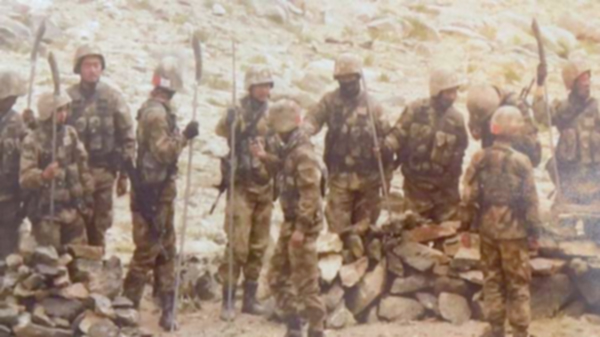Between Simmer and Boil
The guandao-armed PLA soldiers at Mukhpari
By Bharat Karnad
Hearing the Chinese Foreign Ministry spokesman say the near-clash September 7 at Mukhpari was due to the Indian army offering “serious provocation of an egregious nature” and then have the MEA accuse the People’s Liberation Army (PLA) for “blatantly violating agreements and carrying out aggressive manoeuvres” and firing small arms, a third country tuning in may find it hard to blame one or the other side for ratcheting up proceedings.
This confusion would have persisted but for a picture of the incident snapped by a mobile camera and flashed to the India media. It shows 15-20 Chinese troops, some of them unusually large-bodied specially chosen for this intimidation mission in padded body armour. They had automatic rifles slung across their shoulders, standing over a small stone wall marking Indian Territory, shouting and gesturing with ‘guandaos’ in their hands.
Guandao is a Chinese polearm a long lance with a slightly curved scything blade, a weapon from the 3rd Century AD in the time of the Eastern Wu Dynasty. It conforms with the PLA use of the slightly more modern, but still medieval, nailed maces in the June 15 confrontation in the Galwan Valley that led to the killing of 20 personnel of the 16 Bihar Regiment. The PLA may not think such regression is the future of war.
But it apparently believes it can use museum pieces, instead of in-date arms, to escape the charge of initiating military hostilities, and to shove the forward-deployed Indian mountain infantrymen, not similarly equipped, into escalating matters by reacting with automatic gun fire. Post-Galwan clash, Indian troops, if attacked, are instructed to use their assault weapons.
By such contrivances, Beijing hopes to make India responsible for starting a fracas, violating existing agreements on the use of force on the disputed border, and to secure an excuse for military escalation. It is a clever ruse the Indian government and military seem to be dumbfounded by when such PLA tactics can be easily countered by arming troops with nail-spiked steel maces, etc. to enable them to respond in kind, which hasn’t been done.
The fact that the Indian jawans at Mukhpari neither flinched nor reacted precipitately in the face of jeering PLA troops itching for a fight and discharged their weapons in the air only in response to the Chinese doing the same, indicates tremendous discipline on their part. Following on the success of the Tibetan-manned Special Frontier Force (SFF) to surreptitiously secure Black Top on the night of August 29, it is a genuine psychological and tactical military reverse for the Chinese.
Black Top is the highest point in the Kailash mountain range surrounding the Spanggur Lake and Indian occupation of it renders vulnerable the PLA presence at lesser heights and its post at Moldo hosting artillery and a fleet of armoured vehicles. It does three other things dominates all east-west routes in the vicinity, blocks the PLA from realizing its original objective capturing the southern shore of the Pangong Tso and, according to the former Northern Army commander, Lieutenant General HS Panag, enables Indian units to move to the south bank of the Spanggur Lake and even advance northeastwards towards Rudok.
A more confident Indian army, rather than waste time gloating over its so far small successes, should prepare, with fast moving Special Forces (such as the SFF and the Ladakh Scouts) in the van, to take back the area Fingers 4 to 8 on the northern bank of the Pangong Tso, remove the PLA blockade at the Y-junction on the Depsang Plains, dislodge the Chinese from Indian territory around the Hot Springs-Gogra-Kugrang area, secure the mountain ridge on the east bank of the Shyok River to protect the new highway to Daulat Beg Oldi and the access route to the Karakorum Pass, and to fortify the hilltops it occupies in the Kailash Range.
General Panag, for one, rues the Indian army’s “error of judgement” in not occupying the “plateau-like areas” to the east of the Kailash Range which would have preempted their use by the PLA as staging areas for Chinese offensives he expects will be mounted to clear the Indian presence from the Chushul sector, in particular Black Top, which he thinks the Chinese cannot afford to have remain under Indian control.
To thwart PLA attacks, he advises that the approaches to Indian-held positions be mined and embedded with Improvised Explosive Devices. The uptick in the Indian army actions in eastern Ladakh, however, is not matched by equally efficacious Indian diplomacy. Commenting on the Chinese disregarding numerous “understandings” since 1993 to limit forces that can be deployed on the LAC and to restrain them, the external affairs minister (EAM) S. Jaishankar, had nothing very profound to say other than that this “raises very, very important questions” and “calls for very, very deep conversations between the two sides at the political level.” All this may be very, very good but doesn’t progress a diplomatic solution any.
In fact, it hints at the EAM kicking the can down the road, putting the onus on Prime Minister Narendra Modi to resolve the problem at his level with Chinese President Xi Jinping. This is a reasonable conclusion to reach considering Jaishankar in his video conversations achieved nothing and is unlikely to accomplish much in the luncheon meeting with his Chinese counterpart Wang Yi in Moscow, September 10, and neither did the National Security Adviser (NSA) Ajit Doval who video-conferenced with Wang on July 5. If anything, there’s every possibility that Wang is playing Doval off against Jaishankar. Because policy- and decision-making processes in the Government of India are famously stove-piped and coordination is nonexistent, NSA and EAM on separate tracks negotiating with the same Chinese interlocuter, may further differently nuanced aims and agendas a situation Wang is bound to milk. Whatever gains the Indian army may register in eastern Ladakh could thus be squandered by Messrs Doval and Jaishankar at the negotiating table.


